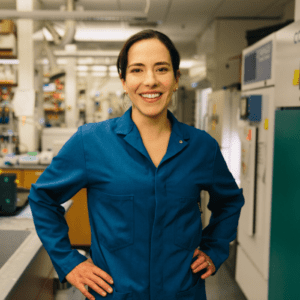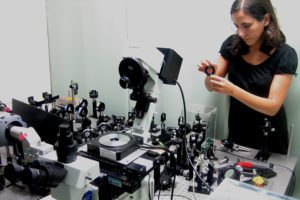Markita del Carpio Landry is an assistant professor in the department of Chemical and Biomolecular Engineering at the University of California, Berkeley, and the principal investigator of the Landry Laboratory, which has pioneered nanotechnologies for in-brain neurotransmitter imaging, and also genetic manipulation in plants. Prof. Landry is also on the scientific advisory board of Terramera and on the scientific advisory board of Chi-Botanic. In the past five years, she has been a recipient of over 20 early career awards, including awards from the Burroughs Wellcome Fund, the Beckman Foundation, the Sloan Foundation, The Dreyfus Foundation, the DARPA Young Investigator program, the Howard Hughes Medical Institute, and a recipient of the NSF CAREER award.
QB3-Berkeley: What’s the focus of your lab’s research?
Markita del Carpio Landry: My lab has developed a suite of near-infrared probes to image neurotransmitters such as dopamine, serotonin, and neuropeptides such as oxytocin, constituting a major advance in neurochemical imaging. By inserting our dopamine probes into the brain extracellular space, we can image dopamine modulation at the spatial and temporal scales relevant to endogenous neurochemical signaling. Importantly, the synthetic nature of these probes enables us to image neurochemistry in the presence of dopamine receptor pharmacology—drugs ubiquitously used to treat psychiatric disorders. These probes and the information they are generating from mouse models of disease could be transformative for understanding disorders such as depression, anxiety, Alzheimer’s disease, Parkinson’s disease, and social autism spectrum disorder. Furthermore, the synthetic nature of our probes represents the only technology by which neuromodulator imaging could be undertaken in non-model organisms such as genetically intractable organisms, or for future use in the clinic.

Separately, my lab has shown that nanomaterials and their associated surface chemistries can be engineered to controllably graft and deliver functional biomolecular cargoes such as whole DNA plasmids and to agriculturally relevant plants. We accomplish nanoparticle-mediated heterologous and transient expression of a protein in plants and show that there is no transgenic DNA integration into the host plant genome. We also work to elucidate the transport mechanisms of nanoparticles in plants, to understand how they transit through plant tissues and under what circumstances they enable delivery of DNA and RNA cargoes.
QB3: What’s an exciting question or challenge that your field and/or your lab is trying to answer?
MdCL: Genetic engineering of plants is societally contested, but in about one decade will become a necessary method to keep pace with our changing global climate and diminishing landmass on which to grow crops. Specifically, my lab’s developments can confer desirable traits to plants such as increased yield, abiotic stress tolerance, and disease and pest resistance without transgene integration, which can in turn mitigate the urgent need for sustainable and high-yielding crops in our global environmental conservation efforts. For these reasons, we are exploring methods of genetically or post-transcriptionally modifying plants without DNA integration, or without DNA altogether via RNA or protein delivery by using nanoparticle carriers.
QB3: When did you become interested in becoming a scientist?
MdCL: My mom grew up in Bolivia and was always passionate about her work. She is a telecommunications engineer, and growing up, though I didn’t quite understand her work, I do remember the passion she had for her job was infectious. She was on call during the whole Y2K scare and carried a beeper with her all night. I remember thinking that no matter what happened as computers made the jump from 99 to 00, my mom would be able to fix it! My mom’s passion for her career always made me curious what exactly about science-based careers were so exciting. Today, what I love about science is also what made my mom so passionate about her work back then. On a daily basis, I work with others to solve problems and know that the solutions to those problems could contribute to a better quality of life. I am equally motivated by the knowledge that my presence in STEM sets an example for others from non-traditional backgrounds.
QB3: What advice would you give to students who are interested in your field?
MdCL: When I started my lab, my prior training in physics and chemistry hadn’t prepared me to do the research I was most excited to do: neurobiology and plant genetic engineering. Although I had never done any research with living systems, I took a big risk in pivoting my research directions to neuroscience and plant science when I started my lab. This pivot required me to spend many late nights with introduction to biology textbooks and establishing fruitful cross-disciplinary collaborations. Today, my lab works at the interface of nanoscience, neuroscience, and plant biology, an exciting and eclectic range of research topics. This experience has motivated me to advise young scientists to pursue the science they are most excited by and passionate about. If I managed to get up to speed on a new field and pivot this late in my career, then anybody can do it!
Additionally, self-doubt and imposter syndrome are real hurdles to success, especially for women in science-based careers. Failed experiments are prevalent in science, so it is common to doubt oneself when research projects aren’t going as planned. However, it is important to acknowledge that even a failed experiment or negative results are useful in determining how to move a project forward. Most of my prior research projects were brought to completion through a combination of positive and negative results that together paint a complete picture of the project, and as I gained more experience in research, I learned to celebrate the negative results that came my way.

“A smooth sea never made a skilled sailor” is a quote by Franklin Roosevelt that is highly relevant to science: some of the most successful and creative scientists I know are the ones who have struggled through some of the most difficult scientific projects.
QB3: Are there any forthcoming papers or current projects that you’d be willing to tell us about?
MdCL: Yes! Just yesterday we had a paper published that we tweeted about here. In this manuscript, we use gold nanoparticles of various shapes and sizes to uncover the transport mechanism of nanoparticles in plant tissues, and also study the availability of biological cargoes as they are transported within plant tissues. Our study uncovers that nanoparticle shape and size both greatly influence nanoparticle uptake and the ability of plants to utilize the delivered biological cargoes, with a strict 20 nm size cut-off. Specifically, we attach small interfering RNA (siRNA, a notoriously fragile cargo), and assess the mechanism of the plant’s ability to use siRNA for targeted downregulation of a reporter green fluorescent protein (GFP). We uncover several surprising and counter-intuitive findings as part of our study, including that despite the fact that gold nanospheres do not enter plant cells, 10 nm gold nanospheres are most effective at delivering siRNA cargoes into cells. This finding is particularly important for the plant nano-delivery community, as it suggests that nanoparticle entry into cells is not necessary for siRNA cargo delivery.
We highlight this latter finding as a potential ‘paradigm shifter’ for the field of nanoparticle-based delivery in plants. There is currently much effort in confirming internalization of nanoparticles into plant cells prior to their use as delivery vehicles. Our results highlight that the best delivery nanotechnologies may not need to enter plant cells at all. Our manuscript therefore describes mechanisms of nanoparticle transport in plants to motivate how future endeavors plant delivery should be approached.